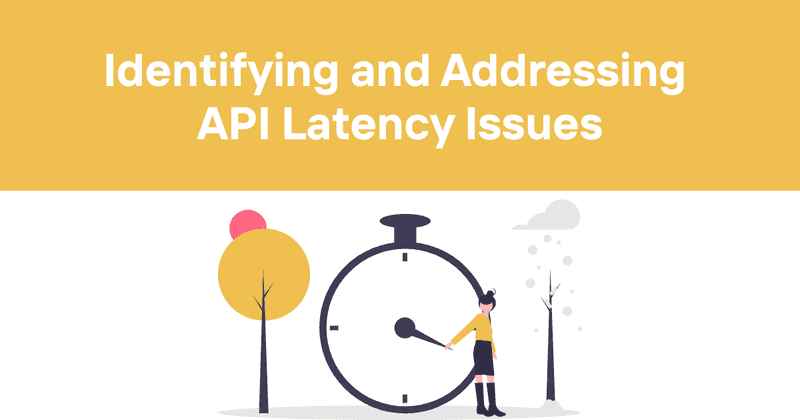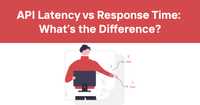Identifying and Addressing API Latency Issues
When your API calls start taking longer than expected, users notice. That slight delay between clicking a button and seeing results can make the difference between a satisfied user and someone who abandons your application entirely. I've spent years optimizing APIs, and in this article, I'll break down everything you need to know about API latency—what causes it, how to measure it, and practical ways to reduce it.
Table of Contents
What is API Latency?
API latency is the time it takes for a data packet to travel from the requesting client to the API server and back again. Think of it as a round-trip journey for your data. When you make an API call, your request travels across the network to the API server, gets processed, and then the response makes its way back to you.
Low API latency means these trips happen quickly—ideally in milliseconds. High latency means users are left waiting, which can lead to poor application performance and frustrated users.
API latency specifically measures the network transit time, not including the processing time on the server. This is a critical distinction many developers miss when troubleshooting performance issues.
Let me put this in perspective: modern applications often aim for API latency under 100ms. At 100-300ms, users start to notice delays. Anything over 300ms feels sluggish to users, and beyond 1000ms (1 second), users may abandon the action entirely.
API Latency vs. Response Time
One common source of confusion is the difference between API latency and response time. They're related but measure different things:
- API Latency: The time spent in data transit between client and server (network travel time only)
- Response Time: The total time from request to response, including both network latency AND server processing time
Here's a simple table to illustrate the difference:
| Metric | What it Measures | Includes Server Processing | Typical Target |
|---|---|---|---|
| API Latency | Network transit time | No | <100ms |
| Response Time | Total request-to-response time | Yes | <300ms |
Response time will always be longer than latency since it includes not just the network travel time but also how long the server takes to process the request. If your response time is high but latency is low, your performance bottleneck is likely on the server side. Conversely, high latency with reasonable processing time indicates network issues.
I once worked on an application where we spent weeks optimizing server code only to discover our main performance issue was network latency caused by routing traffic through data centers on opposite sides of the country. That's the importance of distinguishing between these metrics!
Why API Latency Matters
API latency isn't just a technical consideration—it directly impacts business outcomes. Here's why it matters:
-
User Experience: Users expect near-instantaneous responses. Each 100ms of added latency can reduce conversion rates by up to 7%.
-
Mobile Performance: Mobile networks introduce additional latency, so apps relying on APIs need to be especially latency-conscious.
-
Microservices Architecture: In distributed systems where multiple services communicate via APIs, latency compounds across service calls.
-
Resource Utilization: High-latency requests tie up server resources longer, reducing overall system capacity.
-
Competitive Advantage: In fields like e-commerce or finance, speed is often a critical differentiator.
I've seen firsthand how latency issues can cascade into business problems. One e-commerce client lost an estimated $50,000 in sales during a two-day period where API latency spiked due to network routing issues. Users would add items to their cart but abandon the purchase when checkout API calls became sluggish.
Common Causes of High API Latency
Let's examine the most common culprits behind API latency issues:
Network Factors
- Physical Distance: The farther data needs to travel, the higher the latency.
- Network Congestion: Like traffic jams, data congestion slows everything down.
- Network Hops: Each router or switch adds time to the journey.
- DNS Resolution: Slow DNS lookups add latency before the API call even starts.
Server Factors
- Server Load: Overloaded servers introduce delays in handling requests.
- Resource Constraints: Limited CPU, memory, or disk I/O can create bottlenecks.
- Inefficient Code: Poorly optimized server code increases processing time.
- Database Queries: Slow or unoptimized database operations are common culprits.
Client Factors
- Client-side Processing: Heavy JavaScript execution can delay API requests.
- Mobile Network Conditions: Cellular networks often have higher and more variable latency.
- Battery Optimization: Some mobile devices throttle network activity to save power.
Infrastructure Factors
- Load Balancers: Improperly configured load balancers can add unnecessary latency.
- Proxy Servers: Each additional proxy in the request path adds latency.
- Middleware Processing: API gateways, authentication, and monitoring tools can slow responses.
Sometimes unexpected factors cause latency spikes. I once debugged a mysterious latency issue that only occurred during business hours. After days of investigation, we discovered the problem: a specific ISP was routing traffic through a congested node during peak hours. The solution? We added a CDN edge location that bypassed the problematic route.
How to Measure API Latency
You can't improve what you don't measure. Here are the key approaches to measuring API latency:
Basic Tools
- Ping Tests: Simple network latency checks, though they don't test actual API endpoints.
- cURL with Time Flags: Using
curl -w "%{time_total}\n" http://api-endpointprovides basic timing.
- Browser Developer Tools: The Network tab in Chrome DevTools breaks down request timing.
Advanced Monitoring Solutions
- Application Performance Monitoring (APM) Tools: Solutions like New Relic, Datadog, and AppDynamics provide detailed API latency metrics.
- Synthetic Monitoring: Regular automated API checks from different locations.
- Real User Monitoring (RUM): Measures actual user experiences with your APIs.
- Distributed Tracing: Tracks requests across multiple services for end-to-end visibility.
Key Metrics to Track
- Average Latency: The mean time for API calls.
- Percentiles: Often more useful than averages—p95 and p99 latencies show worst-case experiences.
- Error Rates: Failed requests often correlate with latency issues.
- Geographic Distribution: Latency by user location helps identify regional problems.
- Endpoint Comparison: Different API endpoints may have varying latency profiles.
I recommend setting up dashboards that visualize these metrics over time. Look for patterns—do latency spikes correlate with traffic increases, deployments, or specific times of day? These patterns often provide clues to the underlying causes.
For one project, we created a "latency budget" for each component in our system. This helped us quickly identify which part of the stack was contributing most to overall response time—and where to focus optimization efforts.
8 Effective Strategies to Reduce API Latency
Now for the part you've been waiting for—practical ways to reduce API latency:
1. Content Delivery Networks (CDNs)
CDNs place your content closer to users, dramatically reducing network latency. Even dynamic API responses can benefit from edge computing capabilities offered by modern CDNs.
Implementation tips:
- Use a CDN with edge locations in your key user regions
- Configure appropriate cache headers for cacheable API responses
- Consider edge computing for simple transformations
2. Geographic Distribution
Deploy your API servers in multiple regions to minimize physical distance to users.
Implementation tips:
- Use cloud providers' multi-region capabilities
- Implement smart routing to direct users to the nearest instance
- Consider data replication challenges carefully
3. Connection Optimization
Modern web protocols can significantly reduce latency.
Implementation tips:
- Use HTTP/2 or HTTP/3 to enable multiplexing
- Implement keep-alive connections to avoid handshake overhead
- Consider WebSockets for real-time applications
4. Caching Strategies
Caching is perhaps the most powerful tool for latency reduction.
Implementation tips:
- Implement client-side caching with appropriate cache headers
- Use server-side caching for frequently accessed data
- Consider a distributed cache like Redis for API responses
- Employ cache warming for predictable high-traffic periods
5. Payload Optimization
The less data transmitted, the lower the latency.
Implementation tips:
- Use compression (gzip, Brotli) for API responses
- Implement response filtering to return only needed fields
- Consider binary protocols like Protocol Buffers or MessagePack
- Pagination for large data sets
6. Database Optimization
Database operations are often the biggest contributor to API response times.
Implementation tips:
- Index frequently queried fields
- Use query optimization techniques
- Implement database connection pooling
- Consider read replicas for heavy read workloads
7. Asynchronous Processing
Not everything needs to happen synchronously.
Implementation tips:
- Use background jobs for non-critical operations
- Implement webhooks for event notifications
- Consider event-driven architectures for complex workflows
- Use message queues to decouple services
8. Code and Algorithm Optimization
Sometimes the issue is simply inefficient code.
Implementation tips:
- Profile your code to identify bottlenecks
- Use more efficient algorithms and data structures
- Implement parallel processing where appropriate
- Optimize third-party library usage
I've seen dramatic improvements from these techniques. At one company, we reduced average API latency by 65% by implementing just three changes: moving to HTTP/2, adding strategic caching, and optimizing our most expensive database queries.
But remember: optimization should be data-driven. Measure your baseline, implement changes one at a time, and verify the impact before moving to the next optimization.
API Latency Monitoring Best Practices
Ongoing monitoring is crucial for maintaining low API latency. Here are best practices I've developed over years of API management:
Set Clear Baselines and SLAs
Define what "good" latency looks like for your APIs. Common targets include:
- Critical user-facing APIs: <100ms p95 latency
- Background operations: <500ms p95 latency
Document these as Service Level Objectives (SLOs) and track compliance.
Implement Multi-region Monitoring
Measure API latency from different geographic locations to understand the user experience globally. What's fast from your office might be slow from another continent.
Use Synthetic and Real User Monitoring
Synthetic monitoring provides consistent baseline measurements, while Real User Monitoring shows actual user experience. Both are valuable.
Set Up Alerting with Context
Alert on latency thresholds, but include context:
- Is the issue affecting all endpoints or just some?
- Is it regional or global?
- Did it coincide with a deployment or traffic spike?
Create Latency Heat Maps
Visualize latency across different dimensions:
- Time of day
- Geographic region
- API endpoint
- Client type
Heat maps make patterns much easier to spot than simple line graphs.
Track Correlations
Monitor correlations between latency and other metrics:
- Server resource utilization
- Database connection pool usage
- Concurrent users
- Network bandwidth
I've found that maintaining a "latency journal" during incidents helps identify patterns over time. Document what changed when latency spiked, what the fix was, and any early warning signs you noticed.
Real-world Examples of API Latency Issues
Sometimes the best way to understand API latency challenges is through real examples:
Case Study 1: The Mobile API That Wasn't
A mobile app was experiencing poor performance despite the API showing good response times in monitoring. The issue? The monitoring was conducted from cloud servers with excellent connectivity, while actual users on mobile networks experienced much higher latency. The solution was implementing a more efficient data synchronization strategy and adding compressed payload options specifically for cellular connections.
Case Study 2: The Database Connection Bottleneck
An e-commerce platform experienced latency spikes during peak shopping hours. Investigation revealed that the API servers were opening and closing database connections for each request. Implementing connection pooling reduced average latency by 150ms, which translated to a 12% increase in conversion rate.
Case Study 3: The Third-party API Chain
A financial services application depended on multiple third-party APIs. Each worked well individually, but the sequential chain of calls created unacceptable total latency. The solution was implementing parallel requests where possible and adding a caching layer for frequently accessed and slowly-changing data.
Case Study 4: The Silent DNS Issue
A media company experienced intermittent latency spikes that were difficult to trace. The root cause turned out to be DNS resolution timeouts causing periodic delays before API calls even started. Implementing DNS caching and switching to a more reliable DNS provider resolved the issue.
These examples highlight the importance of holistic monitoring and thinking beyond your own infrastructure when troubleshooting latency issues.
How Odown Can Help Monitor API Latency
Monitoring API latency requires specialized tools, and this is where Odown shines. As an uptime and performance monitoring platform, Odown provides several key capabilities for API latency management:
Comprehensive API Monitoring
Odown allows you to monitor your APIs from multiple locations worldwide, giving you a true picture of how users experience your service globally. This geographic distribution is crucial for identifying regional network issues that might affect only certain user segments.
Detailed Latency Metrics
Beyond simple up/down monitoring, Odown provides detailed latency metrics including:
- Average response time
- Percentile breakdowns (p95, p99)
- Historical trends for spotting gradual degradation
Customizable Alerting
Set up alerts for when API latency exceeds your thresholds, with notification options including:
- SMS
- Slack and other popular messaging platforms
- Webhook integration with your existing systems
Public Status Pages
When latency issues do occur, communication is critical. Odown's public status pages allow you to:
- Automatically display current API performance
- Communicate ongoing issues to users
- Show historical uptime and performance
SSL Certificate Monitoring
API security is closely tied to performance. Odown's SSL certificate monitoring helps prevent security-related performance issues by:
- Tracking certificate expiration
- Verifying proper SSL configuration
- Alerting on potential security issues that could affect API performance
For any organization serious about API performance, having a reliable monitoring solution like Odown is no longer optional—it's essential for maintaining user satisfaction and operational excellence.
Conclusion
API latency is a complex but manageable aspect of modern application development. By understanding the difference between latency and response time, identifying common causes of latency issues, implementing strategic optimizations, and monitoring performance consistently, you can deliver a responsive and reliable API experience to your users.
Remember that API latency optimization is rarely a one-time effort. As your application evolves, traffic patterns change, and new features are added, ongoing attention to latency is required. The strategies outlined in this article provide a framework for both immediate improvements and long-term latency management.
For effective latency monitoring, consider implementing a specialized solution like Odown. With its comprehensive API monitoring capabilities, detailed latency metrics, customizable alerts, and public status pages, Odown provides the visibility and tools needed to ensure your APIs perform at their best.
What API latency challenges have you faced in your applications? Have you implemented any of these optimization strategies? Share your experiences in the comments below.



